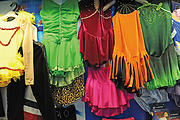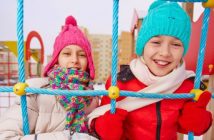Figure skating for beginners
 It’s Tuesday afternoon and a dozen kids are zipping around the Le Cool ice skating rink at Guomao shopping mall. One of them is 10-year-old Wang Zichen, who is practicing a one-and-and-half revolution jump-spin that she just learned a few weeks ago. Her tall, slim body moves to music in a graceful curve – arms spread like wings, feet gliding in rhythm, her purple skirt fluttering in the breeze.
It’s Tuesday afternoon and a dozen kids are zipping around the Le Cool ice skating rink at Guomao shopping mall. One of them is 10-year-old Wang Zichen, who is practicing a one-and-and-half revolution jump-spin that she just learned a few weeks ago. Her tall, slim body moves to music in a graceful curve – arms spread like wings, feet gliding in rhythm, her purple skirt fluttering in the breeze.
Instructor Hu Xiao’ou is sternly correcting Zichen’s poses, but he can hardly conceal his pride in her. “Zichen was a shy kid when she first came here to learn skating six years ago,” says Hu with a smile, “but now she is an excellent public performer and expresses herself freely through music and movement.”
 Indeed, few sports combine athleticism, music and dance as perfectly as ice skating. Kids can benefit in countless ways from ice-skating; it energizes the body, improves lung and heart function and cultivates good balance, flexibility and rhythm. Kids learn courage and perseverance, not to mention self-confidence.
Indeed, few sports combine athleticism, music and dance as perfectly as ice skating. Kids can benefit in countless ways from ice-skating; it energizes the body, improves lung and heart function and cultivates good balance, flexibility and rhythm. Kids learn courage and perseverance, not to mention self-confidence.
Learning to ice skate doesn’t require any special body types or abilities – most children over 4 years old can take up the sport. For a complete beginner, the first step is learning the right way to stand and walk on ice (holding on to the practice bar with one or both hands, stand with the legs shoulder-width apart, bend the knees slightly and turn the toes out). After you can stand steadily on ice, use your legs and hips to push the skate blades, one foot at a time, against the ice to move forward.
When novices practice, falls are inevitable. Therefore it’s crucial to fall the correct way to avoid serious injuries (lean forward slowly and fall on your knees). “Many beginners panic and fall back on their buttocks when they feel that they’re losing balance,” says Hu. “That is dangerous because they could crush their bones with their body weight.”
 Proper protection is required, especially for a beginner – helmet, gloves, kneepads, elbow pads and wrist pads are necessary for first-timers. For higher-level skaters who do more complicated movements, hip pads sometimes are needed, too.
Proper protection is required, especially for a beginner – helmet, gloves, kneepads, elbow pads and wrist pads are necessary for first-timers. For higher-level skaters who do more complicated movements, hip pads sometimes are needed, too.
When ice skating originated in Scandinavia thousands of years ago, people strapped flattened animal bones to the bottom of their feet to glide on top of ice. Today, skaters’ boots are fitted with steel blades, sharp edges that cut into the ice to help skaters control their movements. Blades for figure skating have a toe pick at the front. “The toe pick assists in jumps, spins and stops for the more skilled skaters,” says Hu. “That’s why more aggressive toe picks suit them better. But for beginners, smaller and weaker toe picks are recommended since catching the toe pick unexpectedly can cause them to fall down.”
 Falling down can hurt. But like most things in life, it’s getting up after the fall that makes kids stronger. Zichen, the young skater, did not gain her skills effortlessly. In her attempts to learn jumping and spinning, she fell so many times that her legs were often black and blue all over. “My daughter wasn’t as gifted in skating like some other kids, but she has a surprisingly determined spirit when it comes to figure skating,” says Zichen’s mother Chen Yu. “She wouldn’t quit despite the bruises, and I’ve never heard her complain or cry out in pain.
Falling down can hurt. But like most things in life, it’s getting up after the fall that makes kids stronger. Zichen, the young skater, did not gain her skills effortlessly. In her attempts to learn jumping and spinning, she fell so many times that her legs were often black and blue all over. “My daughter wasn’t as gifted in skating like some other kids, but she has a surprisingly determined spirit when it comes to figure skating,” says Zichen’s mother Chen Yu. “She wouldn’t quit despite the bruises, and I’ve never heard her complain or cry out in pain.
Zichen recently passed Level 5 of the national junior figure skating test (10 is the highest level) and hopes to move up a level next year. “I love ice skating because it’s beautiful,” she says. “It makes me feel like I can fly. I will continue to ice skate as long as I can. ”
Le Cool Ice Rink
Daily 10am-10pm
RMB 30 (Mon-Fri, 10am-6pm); RMB 40 (Mon-Thu, 6-10pm); RMB 50 (Fri, 6-10pm and weekends), including skate rental
B2/F, China World Shopping Mall, 1 Jianguomenwai Dajie, Chaoyang District (6505 5776, 6535 8666: lecool@cwtc.com)
国贸溜冰场,朝阳区建国门外大街1号国贸商城地下2层
www.lecoolicerink.com



